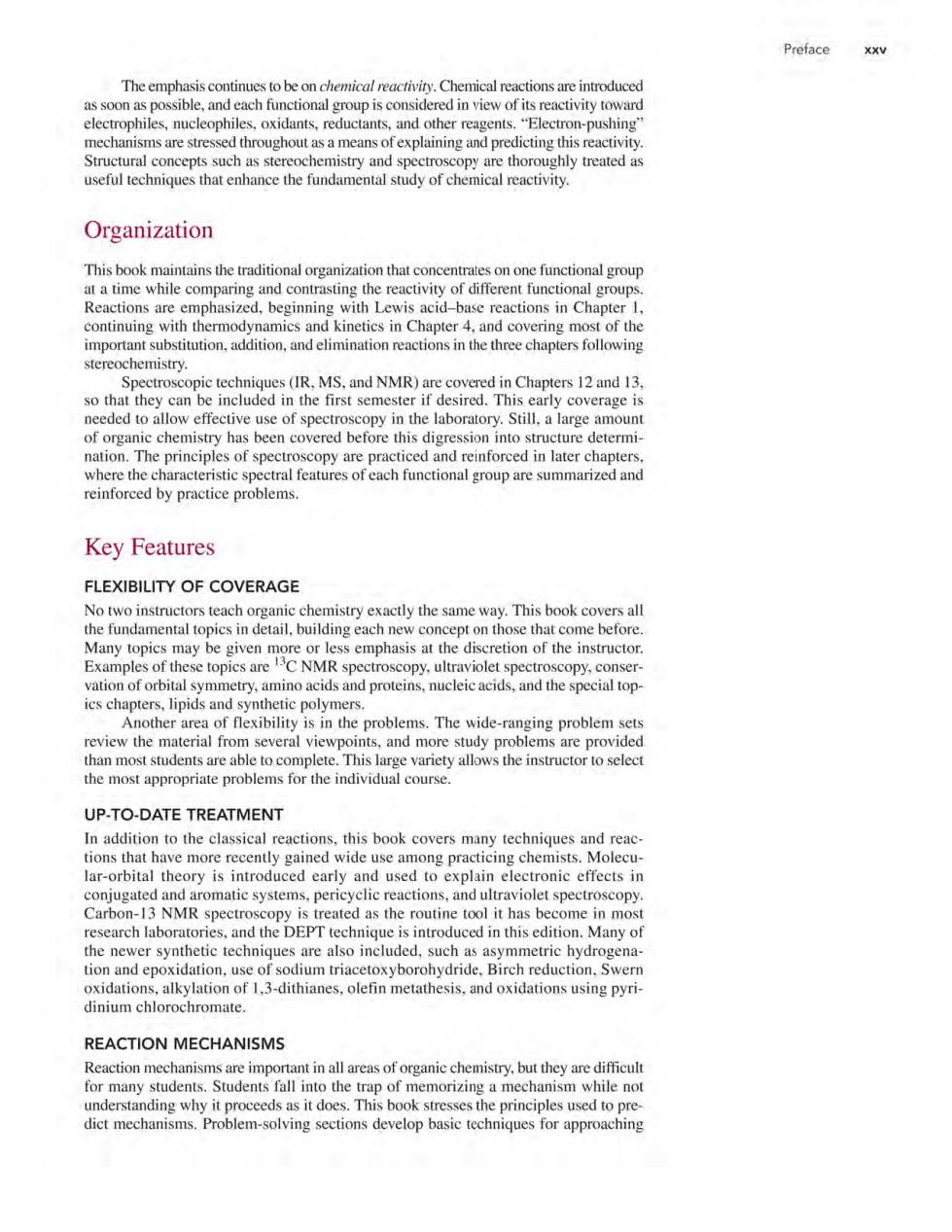正在加载图片...

Preface XXV The emphasis continues to be on chemical reactivity chemical reactions are introduce as soon as possible,and each functional group is considered in view of its reactivity toward electrophiles,nucleophiles.oxidants,reductants,and other reagents."Electron-pushing mechanisms are stres Organization This book maintains the traditional organization that concentrates on one functional group a a time while comparing and contrasting the reactivity of different functional groups R st of the important substitution,addition,and elimination reactions in the three chapters following stereochemistry. Spectros opic tec o tha the f needed to allow effective use of spectroscopy in the laboratory.Still.a large amount of organic chemistry has been covered before this digression into structure determi hrCtabypeeicepobiem Key Features FLEXIBILITY OF COVERAGE No two instructors teach organic ch This book c the fundamental topics in detail buildins Many topics maybeivemoemphasis ctionof the ncor. Examples of these topics are vation of orbital cs cl Another area of fexibility is in the problems.The wide-ranging problem sets review the material from several viewpoints,and more study problems are provided than most studen the most appropriste problempche instructor to selcct course UP-TO-DATE TREATMENT In addition to the classical reactions.this book covers ma lar-orbital theory is introduced early and used to explain electronic effects in matic systems,per olet spectr research laboratories.and the DEPT technigue is introduced in this edition.Mar the newer synthetic techniques are also included,such as asymmetric hydrogena hydride,Bire reduction.Swerr tons using pyr REACTION MECHANISMS Reaction mechanisms are impor tant in all areas of organic chemistry.but they are difficult for many students.Students fall into the trap of memorizing a mechanism while not ict mechaimPobem-oingec This b m-solving sections develop b for approachingThe emphasis continues to be on chemical reactivity. Chemical reactions are introduced as soon as possible, and each functional group is considered in view of its reactivity toward electrophiles, nucleophiles, oxidants, reductants, and other reagents. "Electron-pushing" mechanisms are stressed throughout as a means of explaining and predicting this reactivity. Structural concepts such as stereochemistry and spectroscopy are thoroughly treated as useful techniques that enhance the fundamental study of chemical reactivity. Organization This book maintains the traditional organization that concentrates on one functional group at a time while comparing and contrasting the reactivity of different functional groups. Reactions are emphasized, beginning with Lewis acid-base reactions in Chapter 1, continuing with thermodynamics and kinetics in Chapter 4, and covering most of the important substitution, addition, and elimination reactions in the three chapters following stereochemistry. Spectroscopic techniques (IR, MS, and NMR) are covered in Chapters 12 and 13, so that they can be included in the first semester if desired. This early coverage is needed to allow effective use of spectroscopy in the laboratory. Still, a large amount of organic chemistry has been covered before this digression into structure determination. The principles of spectroscopy are practiced and reinforced in later chapters, where the characteristic spectral features of each functional group are summarized and reinforced by practice problems. Key Features FLEXIBILITY OF COVERAGE No two instructors teach organic chemistry exactly the same way. This book covers all the fundamental topics in detail, building each new concept on those that come before. Many topics may be given more or less emphasis at the discretion of the instructor. Examples of these topics are 13C NMR spectroscopy, ultraviolet spectroscopy, conservation of orbital symmetry, amino acids and proteins, nucleic acids, and the special topics chapters, lipids and synthetic polymers. Another area of flexibility is in the problems. The wide-ranging problem sets review the material from several viewpoints, and more study problems are provided than most students are able to complete. This large variety allows the instructor to select the most appropriate problems for the individual course. UP-TO-DATE TREATMENT In addition to the classical reactions, this book covers many techniques and reactions that have more recently gained wide use among practicing chemists. Molecular-orbital theory is introduced early and used to explain electronic effects in conjugated and aromatic systems, pericyclic reactions, and ultraviolet spectroscopy. Carbon-13 NMR spectroscopy is treated as the routine tool it has become in most research laboratories, and the DEPT technique is introduced in this edition. Many of the newer synthetic techniques are also included, such as asymmetric hydrogenation and epoxidation, use of sodium triacetoxyborohydride, Birch reduction, Swern oxidations, alkylation of 1,3-dithianes, olefin metathesis, and oxidations using pyridinium chlorochromate. REACTION MECHANISMS Reaction mechanisms are important in all areas of organic chemistry, but they are difficult for many students. Students fall into the trap of memorizing a mechanism while not understanding why it proceeds as it does. This book stresses the principles used to predict mechanisms. Problem-solving sections develop basic techniques for approaching Preface xxv